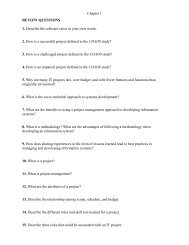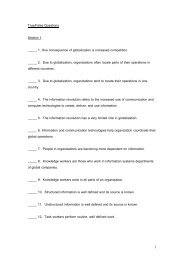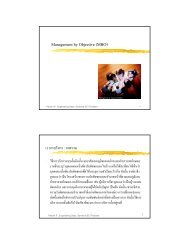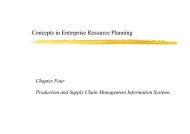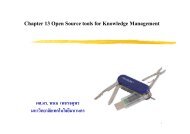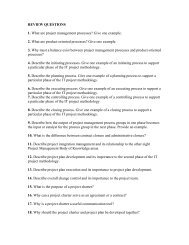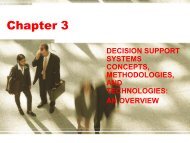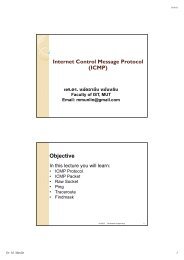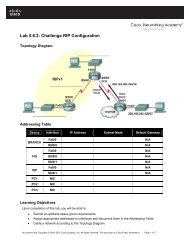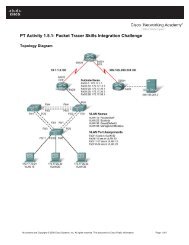Procedural Lab Template, Student Version, Required Components
Procedural Lab Template, Student Version, Required Components
Procedural Lab Template, Student Version, Required Components
- No tags were found...
You also want an ePaper? Increase the reach of your titles
YUMPU automatically turns print PDFs into web optimized ePapers that Google loves.
<strong>Lab</strong> 2.5.1: Basic PPP Configuration <strong>Lab</strong>Topology DiagramAddressing TableDevice Interface IP Address Subnet MaskR1R2R3DefaultGatewayFa0/1 192.168.10.1 255.255.255.0 N/AS0/0/0 10.1.1.1 255.255.255.252 N/ALo0 209.165.200.225 255.255.255.224 N/AS0/0/0 10.1.1.2 255.255.255.252 N/AS0/0/1 10.2.2.1 255.255.255.252 N/AFa0/1 192.168.30.1 255.255.255.0 N/AS0/0/1 10.2.2.2 255.255.255.252 N/APC1 NIC 192.168.10.10 255.255.255.0 192.168.10.1PC3 NIC 192.168.30.10 255.255.255.0 192.168.30.1All contents are Copyright © 1992–2007 Cisco Systems, Inc. All rights reserved. This document is Cisco Public Information. Page 1 of 20
CCNA ExplorationAccessing the WAN: PPP<strong>Lab</strong> 2.5.1: Basic PPP ConfigurationLearning ObjectivesUpon completion of this lab, you will be able to:• Cable a network according to the topology diagram.• Erase the startup configuration and reload a router to the default state.• Perform basic configuration tasks on a router.• Configure and activate interfaces.• Configure OSPF routing on all routers.• Configure PPP encapsulation on all serial interfaces.• Learn about the debug ppp negotiation and debug ppp packet commands.• Learn how to change the encapsulation on the serial interfaces from PPP to HDLC.• Intentionally break and restore PPP encapsulation.• Configure PPP PAP and CHAP authentication.• Intentionally break and restore PPP PAP and CHAP authentication.ScenarioIn this lab, you will learn how to configure PPP encapsulation on serial links using the networkshown in the topology diagram. You will also learn how to restore serial links to their defaultHDLC encapsulation. Pay special attention to what the output of the router looks like when youintentionally break PPP encapsulation. This will assist you in the Troubleshooting lab associatedwith this chapter. Finally, you will configure PPP PAP authentication and PPP CHAPauthentication.Task 1: Prepare the NetworkStep 1: Cable a network that is similar to the one in the topology diagram.You can use any current router in your lab as long as it has the required interfaces shown in thetopology diagram.Note: If you use 1700, 2500, or 2600 routers, the router outputs and interface descriptions appeardifferently.Step 2: Clear any existing configurations on the routers.Task 2: Perform Basic Router ConfigurationConfigure the R1, R2, and R3 routers according to the following guidelines:• Configure the router hostname.• Disable DNS lookup.• Configure an EXEC mode password.• Configure a message-of-the-day banner.• Configure a password for console connections.All contents are Copyright © 1992–2007 Cisco Systems, Inc. All rights reserved. This document is Cisco Public Information. Page 2 of 20
CCNA ExplorationAccessing the WAN: PPP<strong>Lab</strong> 2.5.1: Basic PPP Configuration• Configure synchronous logging.• Configure a password for vty connections.Task 3: Configure and Activate Serial and Ethernet AddressesStep 1: Configure interfaces on R1, R2, and R3.Configure the interfaces on the R1, R2, and R3 routers with the IP addresses from the addressingtable at the beginning of the lab. Be sure to include the clock rate on the serial DCE interfaces.Step 2: Verify IP addressing and interfaces.Use the show ip interface brief command to verify that the IP addressing is correct and that theinterfaces are active.When you have finished, be sure to save the running configuration to the NVRAM of the router.Step 3: Configure the Ethernet interfaces of PC1 and PC3.Configure the Ethernet interfaces of PC1 and PC3 with the IP addresses and default gatewaysfrom the addressing table.Step 4: Test the configuration by pinging the default gateway from the PC.Task 4: Configure OSPF on the RoutersIf you need to review the OSPF commands, see Exploration 2, module 11.Step 1: Enable OSPF routing on R1, R2, and R3.Use the router ospf command with a process ID of 1. Be sure to advertise the networks.R1(config)#router ospf 1R1(config-router)#network 192.168.10.0 0.0.0.255 area 0R1(config-router)#network 10.1.1.0 0.0.0.3 area 0*Aug 17 17:49:14.689: %OSPF-5-ADJCHG: Process 1, Nbr 209.165.200.225 onSerial0/0/0 from LOADING to FULL, Loading DoneR1(config-router)#R2(config)#router ospf 1R2(config-router)#network 10.1.1.0 0.0.0.3 area 0*Aug 17 17:48:40.645: %OSPF-5-ADJCHG: Process 1, Nbr 192.168.10.1 onSerial0/0/0 from LOADING to FULL, Loading DoneR2(config-router)#network 10.2.2.0 0.0.0.3 area 0R2(config-router)#network 209.165.200.224 0.0.0.31 area 0R2(config-router)#*Aug 17 17:57:44.729: %OSPF-5-ADJCHG: Process 1, Nbr 192.168.30.1 onSerial0/0/1 from LOADING to FULL, Loading DoneR2(config-router)#R3(config)#router ospf 1R3(config-router)#network 10.2.2.0 0.0.0.3 area 0*Aug 17 17:58:02.017: %OSPF-5-ADJCHG: Process 1, Nbr 209.165.200.225 onSerial0/0/1 from LOADING to FULL, Loading DoneR3(config-router)#network 192.168.30.0 0.0.0.255 area 0R3(config-router)#All contents are Copyright © 1992–2007 Cisco Systems, Inc. All rights reserved. This document is Cisco Public Information. Page 3 of 20
CCNA ExplorationAccessing the WAN: PPP<strong>Lab</strong> 2.5.1: Basic PPP ConfigurationStep 2: Verify that you have full network connectivity.Use the show ip route and ping commands to verify connectivity.R1#show ip routeOCOOC192.168.30.0/24 [110/1563] via 10.1.1.2, 00:33:56, Serial0/0/0192.168.10.0/24 is directly connected, FastEthernet0/1209.165.200.0/27 is subnetted, 1 subnets209.165.200.225 [110/782] via 10.1.1.2, 00:33:56, Serial0/0/010.0.0.0/8 is variably subnetted, 3 subnets, 2 masks10.2.2.0/30 [110/1562] via 10.1.1.2, 00:33:56, Serial0/0/010.1.1.0/30 is directly connected, Serial0/0/0R1#ping 192.168.30.1Type escape sequence to abort.Sending 5, 100-byte ICMP Echos to 192.168.30.1, timeout is 2 seconds:!!!!!Success rate is 100 percent (5/5), round-trip min/avg/max = 32/32/32 msR1#R2#show ip routeOOCCC192.168.30.0/24 [110/782] via 10.2.2.2, 00:33:04, Serial0/0/1192.168.10.0/24 [110/782] via 10.1.1.1, 00:33:04, Serial0/0/0209.165.200.0/27 is subnetted, 1 subnets209.165.200.224 is directly connected, Loopback010.0.0.0/8 is variably subnetted, 4 subnets, 2 masks10.2.2.0/30 is directly connected, Serial0/0/110.1.1.0/30 is directly connected, Serial0/0/0R2#ping 192.168.30.1Type escape sequence to abort.Sending 5, 100-byte ICMP Echos to 192.168.30.1, timeout is 2 seconds:!!!!!Success rate is 100 percent (5/5), round-trip min/avg/max = 16/16/16 msR2#ping 192.168.10.1Type escape sequence to abort.Sending 5, 100-byte ICMP Echos to 192.168.10.1, timeout is 2 seconds:!!!!!Success rate is 100 percent (5/5), round-trip min/avg/max = 16/16/16 msR2#R3#show ip routeCO192.168.30.0/24 is directly connected, FastEthernet0/1192.168.10.0/24 [110/1563] via 10.2.2.1, 00:32:01, Serial0/0/1209.165.200.0/27 is subnetted, 1 subnetsAll contents are Copyright © 1992–2007 Cisco Systems, Inc. All rights reserved. This document is Cisco Public Information. Page 4 of 20
CCNA ExplorationAccessing the WAN: PPP<strong>Lab</strong> 2.5.1: Basic PPP ConfigurationOCO209.165.200.225 [110/782] via 10.2.2.1, 00:32:01, Serial0/0/110.0.0.0/8 is variably subnetted, 3 subnets, 2 masks10.2.2.0/30 is directly connected, Serial0/0/110.1.1.0/30 [110/1562] via 10.2.2.1, 00:32:01, Serial0/0/1R3#ping 209.165.200.225Type escape sequence to abort.Sending 5, 100-byte ICMP Echos to 209.165.200.225, timeout is 2seconds:!!!!!Success rate is 100 percent (5/5), round-trip min/avg/max = 16/16/16 msR3#ping 192.168.10.1Type escape sequence to abort.Sending 5, 100-byte ICMP Echos to 192.168.10.1, timeout is 2 seconds:!!!!!Success rate is 100 percent (5/5), round-trip min/avg/max = 32/32/32 msR3#Task 5: Configure PPP Encapsulation on Serial InterfacesStep 1: Use the show interface command to check whether HDLC is the default serialencapsulation.R1#show interface serial0/0/0Serial0/0/0 is up, line protocol is upHardware is GT96K SerialInternet address is 10.1.1.1/30MTU 1500 bytes, BW 128 Kbit, DLY 20000 usec,reliability 255/255, txload 1/255, rxload 1/255Encapsulation HDLC, loopback not setR2#show interface serial 0/0/0Serial0/0/0 is up, line protocol is upHardware is GT96K SerialInternet address is 10.1.1.2/30MTU 1500 bytes, BW 128 Kbit, DLY 20000 usec,reliability 255/255, txload 1/255, rxload 1/255Encapsulation HDLC, loopback not setR2#show interface serial 0/0/1Serial0/0/1 is up, line protocol is upHardware is GT96K SerialInternet address is 10.2.2.1/30MTU 1500 bytes, BW 128 Kbit, DLY 20000 usec,reliability 255/255, txload 1/255, rxload 1/255Encapsulation HDLC, loopback not setAll contents are Copyright © 1992–2007 Cisco Systems, Inc. All rights reserved. This document is Cisco Public Information. Page 5 of 20
CCNA ExplorationAccessing the WAN: PPP<strong>Lab</strong> 2.5.1: Basic PPP ConfigurationR3#show interface serial 0/0/1Serial0/0/1 is up, line protocol is upHardware is GT96K SerialInternet address is 10.2.2.2/30MTU 1500 bytes, BW 128 Kbit, DLY 20000 usec,reliability 255/255, txload 1/255, rxload 1/255Encapsulation HDLC, loopback not setStep 2: Use debug commands on R1 and R2 to see the effects of configuring PPP.R1#debug ppp negotiationPPP protocol negotiation debugging is onR1#debug ppp packetPPP packet display debugging is onR1#R2#debug ppp negotiationPPP protocol negotiation debugging is onR2#debug ppp packetPPP packet display debugging is onR2#Step 3: Change the encapsulation of the serial interfaces from HDLC to PPP.Change the encapsulation type on the link between R1 and R2, and observe the effects. If youstart to receive too much debug data, use the undebug all command to turn debugging off.R1(config)#interface serial 0/0/0R1(config-if)#encapsulation pppR1(config-if)#*Aug 17 19:02:53.412: %OSPF-5-ADJCHG: Process 1, Nbr 209.165.200.225 onSerial0/0/0 from FULL to DOWN, Neighbor Down: Interface down ordetachedR1(config-if)#*Aug 17 19:02:53.416: Se0/0/0 PPP: Phase is DOWN, Setup*Aug 17 19:02:53.416: Se0/0/0 PPP: Using default call direction*Aug 17 19:02:53.416: Se0/0/0 PPP: Treating connection as a dedicatedline*Aug 17 19:02:53.416: Se0/0/0 PPP: Session handle[E4000001] Sessionid[0]*Aug 17 19:02:53.416: Se0/0/0 PPP: Phase is ESTABLISHING, Active Open*Aug 17 19:02:53.424: Se0/0/0 LCP: O CONFREQ [Closed] id 1 len 10*Aug 17 19:02:53.424: Se0/0/0 LCP: MagicNumber 0x63B994DE(0x050663B994DE)R1(config-if)#*Aug 17 19:02:55.412: Se0/0/0 PPP: Outbound cdp packet dropped*Aug 17 19:02:55.432: Se0/0/0 LCP: TIMEout: State REQsent*Aug 17 19:02:55.432: Se0/0/0 LCP: O CONFREQ [REQsent] id 2 len 10*Aug 17 19:02:55.432: Se0/0/0 LCP: MagicNumber 0x63B994DE(0x050663B994DE)*Aug 17 19:02:56.024: Se0/0/0 PPP: I pkt type 0x008F, datagramsize 24link[illegal]*Aug 17 19:02:56.024: Se0/0/0 UNKNOWN(0x008F): Non-NCP packet,discardingR1(config-if)#All contents are Copyright © 1992–2007 Cisco Systems, Inc. All rights reserved. This document is Cisco Public Information. Page 6 of 20
CCNA ExplorationAccessing the WAN: PPP<strong>Lab</strong> 2.5.1: Basic PPP Configuration(0x03060A010102)*Aug 17 19:06:50.872: Se0/0/0 CDPCP: O CONFREQ [Closed] id 1 len 4*Aug 17 19:06:50.872: Se0/0/0 PPP: Process pending ncp packets*Aug 17 19:06:50.876: Se0/0/0 PPP: I pkt type 0x8021, datagramsize 14link[ip]*Aug 17 19:06:50.876: Se0/0/0 IPCP: I CONFREQ [REQsent] id 1 len 10*Aug 17 19:06:50.876: Se0/0/0 IPCP: Address 10.1.1.1(0x03060A010101)*Aug 17 19:06:50.876: Se0/0/0 PPP: I pkt type 0x8207, datagramsize 8link[cdp]*Aug 17 19:06:50.876: Se0/0/0 IPCP: O CONFACK [REQsent] id 1 len 10*Aug 17 19:06:50.876: Se0/0/0 IPCP: Address 10.1.1.1(0x03060A010101)*Aug 17 19:06:50.876: Se0/0/0 CDPCP: I CONFREQ [REQsent] id 1 len 4*Aug 17 19:06:50.876: Se0/0/0 CDPCP: O CONFACK [REQsent] id 1 len 4*Aug 17 19:06:50.876: Se0/0/0 PPP: I pkt type 0x8021, datagramsize 14link[ip]*Aug 17 19:06:50.876: Se0/0/0 IPCP: I CONFACK [ACKseR2(config-if)#nt] id 1 len 10*Aug 17 19:06:50.876: Se0/0/0 IPCP: Address 10.1.1.2(0x03060A010102)*Aug 17 19:06:50.876: Se0/0/0 IPCP: State is Open*Aug 17 19:06:50.876: Se0/0/0 PPP: I pkt type 0x8207, datagramsize 8link[cdp]*Aug 17 19:06:50.876: Se0/0/0 IPCP: Install route to 10.1.1.1*Aug 17 19:06:50.880: Se0/0/0 CDPCP: I CONFACK [ACKsent] id 1 len 4*Aug 17 19:06:50.880: Se0/0/0 CDPCP: State is Open*Aug 17 19:06:50.880: Se0/0/0 PPP: O pkt type 0x0021, datagramsize 80*Aug 17 19:06:50.880: Se0/0/0 IPCP: Add link info for cef entry10.1.1.1*Aug 17 19:06:50.884: Se0/0/0 PPP: I pkt type 0x0021, datagramsize 80link[ip]*Aug 17 19:06:51.848: %LINEPROTO-5-UPDOWN: Line protocol on InterfaceSerial0/0/0, changed state to upR2(config-if)#*Aug 17 19:06:51.888: Se0/0/0 LCP-FS: I ECHOREQ [Open] id 1 len 12magic 0x63BDB9A8*Aug 17 19:06:51.888: Se0/0/0 LCP-FS: O ECHOREP [Open] id 1 len 12magic 0x63BD388C*Aug 17 19:07:00.936: %OSPF-5-ADJCHG: Process 1, Nbr 192.168.10.1 onSerial0/0/0 from LOADING to FULL, Loading DoneWhat happens when one end of the serial link is encapsulated with PPP and the otherend of the link is encapsulated with HDLC?_______________________________________________________________________________________________________________________________________________________________________________________________________________All contents are Copyright © 1992–2007 Cisco Systems, Inc. All rights reserved. This document is Cisco Public Information. Page 8 of 20
CCNA ExplorationAccessing the WAN: PPP<strong>Lab</strong> 2.5.1: Basic PPP ConfigurationWhat steps does PPP go through when the other end of the serial link on R2 isconfigured with PPP encapsulation?______________________________________________________________________________________________________________________________________________________________________________________________________________________________________________________________________________________________________________________________________________________________________________________________________________________________What happens when PPP encapsulation is configured on each end of the serial link?__________________________________________________________________________________________________________________________________________Step 4: Turn off debugging.Turn off debugging if you have not already used the undebug all command.R1#undebug allPort Statistics for unclassified packets is not turned on.All possible debugging has been turned offR1#R2#undebug allPort Statistics for unclassified packets is not turned on.All possible debugging has been turned offR2#Step 5: Change the encapsulation from HDLC to PPP on both ends of the serial linkbetween R2 and R3.R2(config)#interface serial0/0/1R2(config-if)#encapsulation pppR2(config-if)#*Aug 17 20:02:08.080: %OSPF-5-ADJCHG: Process 1, Nbr 192.168.30.1 onSerial0/0/1 from FULL to DOWN, Neighbor Down: Interface down ordetachedR2(config-if)#*Aug 17 20:02:13.080: %LINEPROTO-5-UPDOWN: Line protocol on InterfaceSerial0/0/1, changed state to downR2(config-if)#*Aug 17 20:02:58.564: %LINEPROTO-5-UPDOWN: Line protocol on InterfaceSerial0/0/1, changed state to upR2(config-if)#*Aug 17 20:03:03.644: %OSPF-5-ADJCHG: Process 1, Nbr 192.168.30.1 onSerial0/0/1 from LOADING to FULL, Loading DoneAll contents are Copyright © 1992–2007 Cisco Systems, Inc. All rights reserved. This document is Cisco Public Information. Page 9 of 20
CCNA ExplorationAccessing the WAN: PPP<strong>Lab</strong> 2.5.1: Basic PPP ConfigurationR2(config-if)#*Aug 17 20:03:46.988: %LINEPROTO-5-UPDOWN: Line protocol on InterfaceSerial0/0/1, changed state to downR3(config)#interface serial 0/0/1R3(config-if)#encapsulation pppR3(config-if)#*Aug 17 20:04:27.152: %LINEPROTO-5-UPDOWN: Line protocol on InterfaceSerial0/0/1, changed state to up*Aug 17 20:04:30.952: %OSPF-5-ADJCHG: Process 1, Nbr 209.165.200.225 onSerial0/0/1 from LOADING to FULL, Loading DoneWhen does the line protocol on the serial link come up and the OSPF adjacency isrestored?__________________________________________________________________________________________________________________________________________Step 7: Verify that PPP is now the encapsulation on the serial interfaces.R1#show interface serial0/0/0Serial0/0/0 is up, line protocol is upHardware is GT96K SerialInternet address is 10.1.1.1/30MTU 1500 bytes, BW 128 Kbit, DLY 20000 usec,reliability 255/255, txload 1/255, rxload 1/255Encapsulation PPP, LCP OpenOpen: CDPCP, IPCP, loopback not setR2#show interface serial 0/0/0Serial0/0/0 is up, line protocol is upHardware is GT96K SerialInternet address is 10.1.1.2/30MTU 1500 bytes, BW 128 Kbit, DLY 20000 usec,reliability 255/255, txload 1/255, rxload 1/255Encapsulation PPP, LCP OpenOpen: CDPCP, IPCP, loopback not setR2#show interface serial 0/0/1Serial0/0/1 is up, line protocol is upHardware is GT96K SerialInternet address is 10.2.2.1/30MTU 1500 bytes, BW 128 Kbit, DLY 20000 usec,reliability 255/255, txload 1/255, rxload 1/255Encapsulation PPP, LCP OpenOpen: CDPCP, IPCP, loopback not setR3#show interface serial 0/0/1Serial0/0/1 is up, line protocol is upAll contents are Copyright © 1992–2007 Cisco Systems, Inc. All rights reserved. This document is Cisco Public Information. Page 10 of 20
CCNA ExplorationAccessing the WAN: PPP<strong>Lab</strong> 2.5.1: Basic PPP ConfigurationHardware is GT96K SerialInternet address is 10.2.2.2/30MTU 1500 bytes, BW 128 Kbit, DLY 20000 usec,reliability 255/255, txload 1/255, rxload 1/255Encapsulation PPP, LCP OpenOpen: CDPCP, IPCP, loopback not setTask 7: Break and Restore PPP EncapsulationBy intentionally breaking PPP encapsulation, you will learn about the error messages that aregenerated. This will help you later in the Troubleshooting lab.Step 1: Return both serial interfaces on R2 to their default HDLC encapsulation.R2(config)#interface serial 0/0/0R2(config-if)#encapsulation hdlcR2(config-if)#*Aug 17 20:36:48.432: %OSPF-5-ADJCHG: Process 1, Nbr 192.168.10.1 onSerial0/0/0 from FULL to DOWN, Neighbor Down: Interface down ordetached*Aug 17 20:36:49.432: %LINEPROTO-5-UPDOWN: Line protocol on InterfaceSerial0/0/0, changed state to downR2(config-if)#*Aug 17 20:36:51.432: %LINEPROTO-5-UPDOWN: Line protocol on InterfaceSerial0/0/0, changed state to upR2(config-if)#interface serial 0/0/1*Aug 17 20:37:14.080: %LINEPROTO-5-UPDOWN: Line protocol on InterfaceSerial0/0/0, changed state to downR2(config-if)#encapsulation hdlcR2(config-if)#*Aug 17 20:37:17.368: %OSPF-5-ADJCHG: Process 1, Nbr 192.168.30.1 onSerial0/0/1 from FULL to DOWN, Neighbor Down: Interface down ordetached*Aug 17 20:37:18.368: %LINEPROTO-5-UPDOWN: Line protocol on InterfaceSerial0/0/1, changed state to downR2(config-if)#*Aug 17 20:37:20.368: %LINEPROTO-5-UPDOWN: Line protocol on InterfaceSerial0/0/1, changed state to upR2(config-if)#*Aug 17 20:37:44.080: %LINEPROTO-5-UPDOWN: Line protocol on InterfaceSerial0/0/1, changed state to downR2(config-if)#Why is it useful to intentionally break a configuration?_______________________________________________________________________________________________________________________________________________________________________________________________________________Why do both serial interfaces go down, come back up, and then go back down?All contents are Copyright © 1992–2007 Cisco Systems, Inc. All rights reserved. This document is Cisco Public Information. Page 11 of 20
CCNA ExplorationAccessing the WAN: PPP<strong>Lab</strong> 2.5.1: Basic PPP Configuration_______________________________________________________________________________________________________________________________________________________________________________________________________________Can you think of another way to change the encapsulation of a serial interface fromPPP to the default HDLC encapsulation other than using the encapsulation hdlccommand? (Hint: It has to do with the no command.)______________________________________________________________________________________________________________________________________________________________________________________________________________________________________________________________________________________________________________________________________________________________________________________________________________________________Step 2: Return both serial interfaces on R2 to PPP encapsulation.R2(config)#interface s0/0/0R2(config-if)#encapsulation ppp*Aug 17 20:53:06.612: %LINEPROTO-5-UPDOWN: Line protocol on InterfaceSerial0/0/0, changed state to upR2(config-if)#interface s0/0/1*Aug 17 20:53:10.856: %OSPF-5-ADJCHG: Process 1, Nbr 192.168.10.1 onSerial0/0/0 from LOADING to FULL, Loading DoneR2(config-if)#encapsulation ppp*Aug 17 20:53:23.332: %LINEPROTO-5-UPDOWN: Line protocol on InterfaceSerial0/0/1, changed state to upR2(config-if)#*Aug 17 20:53:24.916: %OSPF-5-ADJCHG: Process 1, Nbr 192.168.30.1 onSerial0/0/1 from LOADING to FULL, Loading DoneR2(config-if)#Task 8: Configure PPP AuthenticationStep 1: Configure PPP PAP authentication on the serial link between R1 and R2.R1(config)#username R1 password ciscoR1(config)#int s0/0/0R1(config-if)#ppp authentication papR1(config-if)#*Aug 22 18:58:57.367: %LINEPROTO-5-UPDOWN: Line protocol on InterfaceSerial0/0/0, changed state to downR1(config-if)#*Aug 22 18:58:58.423: %OSPF-5-ADJCHG: Process 1, Nbr 209.165.200.225 onSerial0/0/0 from FULL to DOWN, Neighbor Down: Interface down ordetachedR1(config-if)#ppp pap sent-username R2 password ciscoAll contents are Copyright © 1992–2007 Cisco Systems, Inc. All rights reserved. This document is Cisco Public Information. Page 12 of 20
CCNA ExplorationAccessing the WAN: PPP<strong>Lab</strong> 2.5.1: Basic PPP ConfigurationWhat happens when PPP PAP authentication is only configured on one end of theserial link?__________________________________________________________________________________________________________________________________________R2(config)#username R2 password ciscoR2(config)#interface Serial0/0/0R2(config-if)#ppp authentication papR2(config-if)#ppp pap sent-username R1 password ciscoR2(config-if)#*Aug 23 16:30:33.771: %LINEPROTO-5-UPDOWN: Line protocol on InterfaceSerial0/0/0, changed state to upR2(config-if)#*Aug 23 16:30:40.815: %OSPF-5-ADJCHG: Process 1, Nbr 192.168.10.1 onSerial0/0/0 from LOADING to FULL, Loading DoneR2(config-if)#What happens when PPP PAP authentication is configured on both ends of the seriallink?__________________________________________________________________________________________________________________________________________Step 2: Configure PPP CHAP authentication on the serial link between R2 and R3.In PAP authentication, the password is not encrypted. While this is certainly better than noauthentication at all, it is still highly preferable to encrypt the password that is being sent acrossthe link. CHAP encrypts the password.R2(config)#username R3 password ciscoR2(config)#int s0/0/1R2(config-if)#ppp authentication chapR2(config-if)#*Aug 23 18:06:00.935: %LINEPROTO-5-UPDOWN: Line protocol on InterfaceSerial0/0/1, changed state to downR2(config-if)#*Aug 23 18:06:01.947: %OSPF-5-ADJCHG: Process 1, Nbr 192.168.30.1 onSerial0/0/1 from FULL to DOWN, Neighbor Down: Interface down ordetachedR2(config-if)#R3(config)#username R2 password cisco*Aug 23 18:07:13.074: %LINEPROTO-5-UPDOWN: Line protocol on InterfaceSerial0/0/1, changed state to upR3(config)#int s0/0/1R3(config-if)#*Aug 23 18:07:22.174: %OSPF-5-ADJCHG: Process 1, Nbr 209.165.200.225 onSerial0/0/1 from LOADING to FULL, Loading DoneR3(config-if)#ppp authentication chapR3(config-if)#All contents are Copyright © 1992–2007 Cisco Systems, Inc. All rights reserved. This document is Cisco Public Information. Page 13 of 20
CCNA ExplorationAccessing the WAN: PPP<strong>Lab</strong> 2.5.1: Basic PPP ConfigurationNotice that the line protocol on interface serial 0/0/1 changes state to UP even beforethe interface is configured for CHAP authentication. Can you guess why this is thecase?_______________________________________________________________________________________________________________________________________________________________________________________________________________Step 3: Review the debug output.To better understand the CHAP process, view the output of the debug ppp authenticationcommand on R2 and R3. Then shut down interface serial 0/0/1 on R2, and issue the noshutdown command on interface serial 0/0/1 on R2.R2#debug ppp authenticationPPP authentication debugging is onR2#conf tEnter configuration commands, one per line. End with CNTL/Z.R2(config)#int s0/0/1R2(config-if)#shutdownR2(config-if)#*Aug 23 18:19:21.059: %OSPF-5-ADJCHG: Process 1, Nbr 192.168.30.1 onSerial0/0/1 from FULL to DOWN, Neighbor Down: Interface down ordetachedR2(config-if)#*Aug 23 18:19:23.059: %LINK-5-CHANGED: Interface Serial0/0/1, changedstate to administratively down*Aug 23 18:19:24.059: %LINEPROTO-5-UPDOWN: Line protocol on InterfaceSerial0/0/1, changed state to downR2(config-if)#no shutdown*Aug 23 18:19:55.059: Se0/0/1 PPP: Using default call direction*Aug 23 18:19:55.059: Se0/0/1 PPP: Treating connection as a dedicatedline*Aug 23 18:19:55.059: Se0/0/1 PPP: Session handle[5B000005] Sessionid[49]*Aug 23 18:19:55.059: Se0/0/1 PPP: Authorization required*Aug 23 18:19:55.063: %LINK-3-UPDOWN: Interface Serial0/0/1, changedstate to up*Aug 23 18:19:55.063: Se0/0/1 CHAP: O CHALLENGE id 48 len 23 from "R2"*Aug 23 18:19:55.067: Se0/0/1 CHAP: I CHALLENGE id 2 len 23 from "R3"*Aug 23 18:19:55.067: Se0/0/1 CHAP: Using hostname from unknown source*Aug 23 18:19:55.067: Se0/0/1 CHAP: Using password from AAA*Aug 23 18:19:55.067: Se0/0/1 CHAP: O RESPONSE id 2 len 23 from "R2"*Aug 23 18:19:55.071: Se0/0/1 CHAP: I RESPONSE id 48 len 23 from "R3"*Aug 23 18:19:55.071: Se0/0/1 PPP: Sent CHAP LOGIN Request*Aug 23 18:19:55.071: Se0/0/1 PPP: Received LOGIN Response PASS*Aug 23 18:19:55.071: Se0/0/1 PPP: Sent LCP AUTHOR Request*Aug 23 18:19:55.075: Se0/0/1 PPP: Sent IPCP AUTHOR Request*Aug 23 18:19:55.075: Se0/0/1 LCP: Received AAA AUTHOR Response PASS*Aug 23 18:19:55.075: Se0/0/1 IPCP: Received AAA AUTHOR Response PASSAll contents are Copyright © 1992–2007 Cisco Systems, Inc. All rights reserved. This document is Cisco Public Information. Page 14 of 20
CCNA ExplorationAccessing the WAN: PPP<strong>Lab</strong> 2.5.1: Basic PPP Configuration*Aug 23 18:19:55.075: Se0/0/1 CHAP: O SUCCESS id 48 len 4*Aug 23 18:19:55.075: Se0/0/1 CHAP: I SUCCESS id 2 len 4*Aug 23 18:19:55.075: Se0/0/1 PPP: Sent CDPCP AUTHOR Request*Aug 23 18:19:55.075: Se0/0/1 CDPCP: Received AAA AUTHOR Response PASS*Aug 23 18:19:55.079: Se0/0/1 PPP: Sent IPCP AUTHOR Request*Aug 23 18:19:56.075: %LINEPROTO-5-UPDOWN: Line protocol on InterfaceSerial0/0/1, changed state to upR2(config-if)#*Aug 23 18:20:05.135: %OSPF-5-ADJCHG: Process 1, Nbr 192.168.30.1 onSerial0/0/1 from LOADING to FULL, Loading DoneR3#debug ppp authenticationPPP authentication debugging is onR3#*Aug 23 18:19:04.494: %LINK-3-UPDOWN: Interface Serial0/0/1, changedstate to downR3#*Aug 23 18:19:04.494: %OSPF-5-ADJCHG: Process 1, Nbr 209.165.200.225 onSerial0/0/1 from FULL to DOWN, Neighbor Down: Interface down ordetached*Aug 23 18:19:05.494: %LINEPROTO-5-UPDOWN: Line protocol on InterfaceSerial0/0/1, changed state to downR3#*Aug 23 18:19:36.494: %LINK-3-UPDOWN: Interface Serial0/0/1, changedstate to up*Aug 23 18:19:36.494: Se0/0/1 PPP: Using default call direction*Aug 23 18:19:36.494: Se0/0/1 PPP: Treating connection as a dedicatedline*Aug 23 18:19:36.494: Se0/0/1 PPP: Session handle[3C000034] Sessionid[52]*Aug 23 18:19:36.494: Se0/0/1 PPP: Authorization required*Aug 23 18:19:36.498: Se0/0/1 CHAP: O CHALLENGE id 2 len 23 from "R3"*Aug 23 18:19:36.502: Se0/0/1 CHAP: I CHALLENGE id 48 len 23 from "R2"*Aug 23 18:19:36.502: Se0/0/1 CHAP: Using hostname from unknown source*Aug 23 18:19:36.506: Se0/0/1 CHAP: Using password from AAA*Aug 23 18:19:36.506: Se0/0/1 CHAP: O RESPONSE id 48 len 23 from "R3"*Aug 23 18:19:36.506: Se0/0/1 CHAP: I RESPONSE id 2 len 23 from "R2"R3#*Aug 23 18:19:36.506: Se0/0/1 PPP: Sent CHAP LOGIN Request*Aug 23 18:19:36.506: Se0/0/1 PPP: Received LOGIN Response PASS*Aug 23 18:19:36.510: Se0/0/1 PPP: Sent LCP AUTHOR Request*Aug 23 18:19:36.510: Se0/0/1 PPP: Sent IPCP AUTHOR Request*Aug 23 18:19:36.510: Se0/0/1 LCP: Received AAA AUTHOR Response PASS*Aug 23 18:19:36.510: Se0/0/1 IPCP: Received AAA AUTHOR Response PASS*Aug 23 18:19:36.510: Se0/0/1 CHAP: O SUCCESS id 2 len 4*Aug 23 18:19:36.510: Se0/0/1 CHAP: I SUCCESS id 48 len 4*Aug 23 18:19:36.514: Se0/0/1 PPP: Sent CDPCP AUTHOR Request*Aug 23 18:19:36.514: Se0/0/1 PPP: Sent IPCP AUTHOR Request*Aug 23 18:19:36.514: Se0/0/1 CDPCP: Received AAA AUTHOR Response PASSR3#*Aug 23 18:19:37.510: %LINEPROTO-5-UPDOWN: Line protocol on InterfaceSerial0/0/1, changed state to upR3#*Aug 23 18:19:46.570: %OSPF-5-ADJCHG: Process 1, Nbr 209.165.200.225 onSerial0/0/1 from LOADING to FULL, Loading DoneR3#All contents are Copyright © 1992–2007 Cisco Systems, Inc. All rights reserved. This document is Cisco Public Information. Page 15 of 20
CCNA ExplorationAccessing the WAN: PPP<strong>Lab</strong> 2.5.1: Basic PPP ConfigurationTask 9: Intentionally Break and Restore PPP CHAP AuthenticationStep 1: Break PPP CHAP authentication.On the serial link between R2 and R3, change the authentication protocol on interface serial 0/0/1to PAP.R2#conf tEnter configuration commands, one per line. End with CNTL/Z.R2(config)#int s0/0/1R2(config-if)#ppp authentication papR2(config-if)#^ZR2#*Aug 24 15:45:47.039: %SYS-5-CONFIG_I: Configured from console byconsoleR2#copy run startDestination filename [startup-config]?Building configuration...[OK]R2#reloadDoes changing the authentication protocol to PAP on interface serial 0/0/1 breakauthentication between R2 and R3?_______________________________________________________________________________________________________________________________________________________________________________________________________________Step 2: Restore PPP CHAP authentication on the serial link.Notice that it is not necessary to reload the router for this change to take effect.R2#conf tEnter configuration commands, one per line. End with CNTL/Z.R2(config)#int s0/0/1R2(config-if)#ppp authentication chapR2(config-if)#*Aug 24 15:50:00.419: %LINEPROTO-5-UPDOWN: Line protocol on InterfaceSerial0/0/1, changed state to upR2(config-if)#*Aug 24 15:50:07.467: %OSPF-5-ADJCHG: Process 1, Nbr 192.168.30.1 onSerial0/0/1 from LOADING to FULL, Loading DoneR2(config-if)#Step 3: Intentionally Break PPP CHAP authentication by changing the password on R3.R3#conf tEnter configuration commands, one per line. End with CNTL/Z.R3(config)#username R2 password ciiscoR3(config)#^ZR3#*Aug 24 15:54:17.215: %SYS-5-CONFIG_I: Configured from console byconsoleR3#copy run startDestination filename [startup-config]?All contents are Copyright © 1992–2007 Cisco Systems, Inc. All rights reserved. This document is Cisco Public Information. Page 16 of 20
CCNA ExplorationAccessing the WAN: PPP<strong>Lab</strong> 2.5.1: Basic PPP ConfigurationBuilding configuration...[OK]R3#reloadAfter reloading, what is the status of the line protocol on serial 0/0/1?__________________________________________________________________________________________________________________________________________Step 4: Restore PPP CHAP authentication by changing the password on R3.R3#conf tEnter configuration commands, one per line. End with CNTL/Z.R3(config)#username R2 password ciscoR3(config)#*Aug 24 16:11:10.679: %LINEPROTO-5-UPDOWN: Line protocol on InterfaceSerial0/0/1, changed state to upR3(config)#*Aug 24 16:11:19.739: %OSPF-5-ADJCHG: Process 1, Nbr 209.165.200.225 onSerial0/0/1 from LOADING to FULL, Loading DoneR3(config)#Task 10: Document the Router ConfigurationsOn each router, issue the show run command and capture the configurations.R1#show run!!hostname R1!!enable secret class!!!no ip domain lookup!username R1 password 0 cisco!!!interface FastEthernet0/1ip address 192.168.10.1 255.255.255.0no shutdown!!interface Serial0/0/0ip address 10.1.1.1 255.255.255.252encapsulation pppclockrate 64000ppp authentication papppp pap sent-username R2 password 0 ciscono shutdownAll contents are Copyright © 1992–2007 Cisco Systems, Inc. All rights reserved. This document is Cisco Public Information. Page 17 of 20
CCNA ExplorationAccessing the WAN: PPP<strong>Lab</strong> 2.5.1: Basic PPP Configuration!!!router ospf 1network 10.1.1.0 0.0.0.3 area 0network 192.168.10.0 0.0.0.255 area 0!!banner motd ^CCUnauthorized access strictly prohibited and prosecutedto the full extent of the law^C!line con 0exec-timeout 0 0password ciscologging synchronousloginline aux 0line vty 0 4password ciscologin!endR2#show run!!hostname R2!!enable secret class!!no ip domain lookup!username R3 password 0 ciscousername R2 password 0 cisco!!!interface Loopback0ip address 209.165.200.225 255.255.255.224!!!interface Serial0/0/0ip address 10.1.1.2 255.255.255.252encapsulation pppppp authentication papppp pap sent-username R1 password 0 ciscono shutdown!interface Serial0/0/1ip address 10.2.2.1 255.255.255.252encapsulation pppclockrate 64000All contents are Copyright © 1992–2007 Cisco Systems, Inc. All rights reserved. This document is Cisco Public Information. Page 18 of 20
CCNA ExplorationAccessing the WAN: PPP<strong>Lab</strong> 2.5.1: Basic PPP Configurationppp authentication chapno shutdown!!router ospf 1network 10.1.1.0 0.0.0.3 area 0network 10.2.2.0 0.0.0.3 area 0network 209.165.200.224 0.0.0.31 area 0!!banner motd ^CUnauthorized access strictly prohibited and prosecuted tothe full extent of the law^C!line con 0exec-timeout 0 0password ciscologging synchronousloginline aux 0line vty 0 4password ciscologin!endR3#show run!!hostname R3!!enable secret class!!!no ip domain lookup!username R2 password 0 cisco!!!interface FastEthernet0/1ip address 192.168.30.1 255.255.255.0no shutdown!!interface Serial0/0/1ip address 10.2.2.2 255.255.255.252encapsulation pppppp authentication chapno shutdown!router ospf 1network 10.2.2.0 0.0.0.3 area 0network 192.168.30.0 0.0.0.255 area 0All contents are Copyright © 1992–2007 Cisco Systems, Inc. All rights reserved. This document is Cisco Public Information. Page 19 of 20
CCNA ExplorationAccessing the WAN: PPP<strong>Lab</strong> 2.5.1: Basic PPP Configuration!!banner motd ^CUnauthorized access strictly prohibited and prosecuted tothe full extent of the law^C!line con 0exec-timeout 0 0password ciscologging synchronousloginline aux 0line vty 0 4password ciscologin!endTask 11: Clean UpErase the configurations and reload the routers. Disconnect and store the cabling. For PC hoststhat are normally connected to other networks, such as the school LAN or the Internet, reconnectthe appropriate cabling and restore the TCP/IP settings.All contents are Copyright © 1992–2007 Cisco Systems, Inc. All rights reserved. This document is Cisco Public Information. Page 20 of 20



